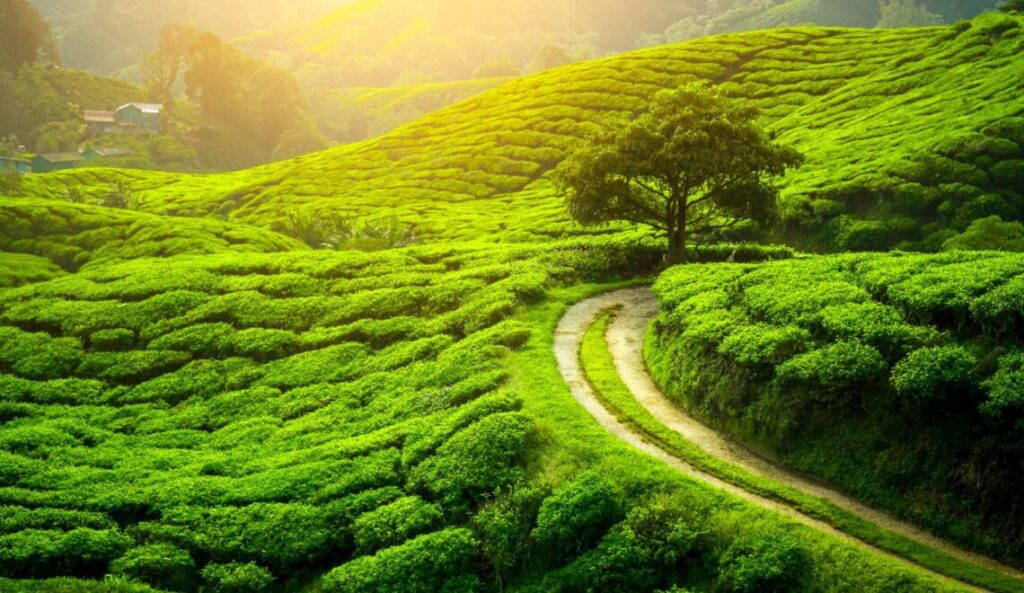Nestled in the serene landscapes of Darjeeling, Rimbik emerges as a tranquil gem, offering a peaceful retreat for nature lovers and adventure seekers.
As one explores the diverse attractions that Darjeeling has to offer, Rimbik stands out as a destination that combines natural beauty with cultural richness. Let’s delve into why Rimbik deserves a prominent spot on the list of places to visit in Darjeeling.
Key Highlights
Rimbik, adorned with enchanting landscapes, is a captivating destination nestled amid the pristine beauty of nature. The region is surrounded by lush greenery, creating a picturesque setting that appeals to the senses and captures the hearts of visitors. Here’s an in-depth exploration of the scenic beauty that defines Rimbik.
1. Lush Greenery:
Rimbik is characterized by lush and verdant greenery, with dense forests and thriving flora contributing to the area’s natural charm. The abundance of trees, shrubs, and vibrant plant life enhances the overall visual appeal, creating a refreshing and rejuvenating atmosphere.
The green canopy provides shade and adds to the tranquility, making Rimbik a perfect retreat for those seeking a connection with nature.
2. Rolling Hills:
The landscape of Rimbik features rolling hills that undulate across the region, forming a series of gentle slopes and valleys. These hills contribute to aesthetic beauty and offer panoramic views of the surrounding mountains.
The gentle contours of the terrain create a soothing and harmonious visual experience for visitors, making it a treat for those who appreciate the undulating beauty of hills.
3. Panoramic Views:
Rimbik is blessed with panoramic views that stretch across the horizon, showcasing the grandeur of the surrounding mountains. The elevated vantage points in the region provide breathtaking vistas, allowing visitors to gaze upon the majestic peaks and valleys that define the landscape.
The panoramic views offer a sense of expansiveness and serenity, inviting contemplation and appreciation of the natural wonders that unfold in every direction.
4. Haven for Nature Enthusiasts:
The pristine beauty of Rimbik transforms it into a haven for nature enthusiasts. Whether it’s the diverse flora, the tranquil ambiance of the hills, or the awe-inspiring views, Rimbik offers a holistic experience for those who revel in the wonders of the natural world.
The region provides opportunities for trekking, nature walks, and bird watching, allowing visitors to immerse themselves in the unspoiled beauty of the surroundings.
5. Scenic Beauty:
Enchanting Landscapes: Rimbik is embraced by picturesque landscapes featuring lush greenery, rolling hills, and panoramic views of the surrounding mountains. The pristine beauty of the region makes it a haven for nature enthusiasts.
6. Trekking Hub:
Rimbik is an adventure paradise and a trekking hub, offering enthusiasts a gateway to thrilling trekking trails, with the renowned Sandakphu trek being a highlight.
The region’s strategic location and diverse terrain make it an ideal base for adventurers and trekkers seeking high-altitude experiences and breathtaking vistas. Here’s a deeper exploration of Rimbik as a trekking hub.
7. Gateway to Trekking Trails:
Rimbik is the starting point for various trekking trails, making it a strategic gateway for adventure seekers. One of the most celebrated treks originating from Rimbik is the Sandakphu trek.
The town’s accessibility and proximity to these trails make it a convenient and popular choice for trekkers exploring the pristine Himalayan landscapes.
8. Sandakphu Trek:
The Sandakphu trek is a prominent trail that begins in Rimbik and takes trekkers on an exhilarating journey to the highest point in West Bengal, Sandakphu.
This trek offers panoramic views of the world’s highest peaks, including Mount Everest, Lhotse, and Makalu. The diverse terrain, encompassing dense forests, alpine meadows, and rugged terrains, adds to the trek’s allure.
9. Breathtaking Vistas:
Rimbik’s proximity to high-altitude regions ensures that trekkers are treated to breathtaking vistas throughout their journey. The panoramic views of the snow-capped Himalayan peaks, expansive valleys, and picturesque landscapes create a mesmerizing backdrop for trekkers.
The trekking trails around Rimbik provide opportunities for trekkers to witness the Himalayas’ natural beauty and diverse ecosystems.
10. Diverse Terrain:
The trekking trails around Rimbik traverse diverse terrains, offering a variety of experiences for adventurers. Trekkers encounter dense rhododendron forests, charming villages, alpine meadows adorned with vibrant wildflowers, and challenging ascents that test their skills. The diversity of landscapes ensures that each trekking route provides a unique and memorable adventure.
11. Adventure Hub:
Rimbik has established itself as an adventure hub, attracting trekkers, nature enthusiasts, and thrill-seekers worldwide.
The town provides essential amenities, accommodation options, and local support for trekkers, ensuring a comfortable and well-supported trekking experience.
12. Adventure Paradise:
Rimbik is a gateway to several trekking trails, including the Sandakphu trek. Adventurers and trekkers find Rimbik an ideal base for embarking on journeys that lead to breathtaking vistas and high-altitude experiences.
13. Sandakphu Trek:
Rimbik, adorned with enchanting landscapes, is a captivating destination nestled amid the pristine beauty of nature. The region is surrounded by lush greenery, creating a picturesque setting that appeals to the senses and captures the hearts of visitors. Here’s an in-depth exploration of the scenic beauty that defines Rimbik:
14. Lush Greenery:
Rimbik is characterized by lush and verdant greenery, with dense forests and thriving flora contributing to the area’s natural charm. The abundance of trees, shrubs, and vibrant plant life enhances the overall visual appeal, creating a refreshing and rejuvenating atmosphere.
The green canopy provides shade and adds to the tranquility, making Rimbik a perfect retreat for those seeking a connection with nature.
15. Rolling Hills:
The landscape of Rimbik features rolling hills that undulate across the region, forming a series of gentle slopes and valleys. These hills contribute to aesthetic beauty and offer panoramic views of the surrounding mountains.
The gentle contours of the terrain create a soothing and harmonious visual experience for visitors, making it a treat for those who appreciate the undulating beauty of hills.
16. Panoramic Views:
Rimbik is blessed with panoramic views that stretch across the horizon, showcasing the grandeur of the surrounding mountains.
The elevated vantage points in the region provide breathtaking vistas, allowing visitors to gaze upon the majestic peaks and valleys that define the landscape.
The panoramic views offer a sense of expansiveness and serenity, inviting contemplation and appreciation of the natural wonders that unfold in every direction.
17. Haven for Nature Enthusiasts:
The pristine beauty of Rimbik transforms it into a haven for nature enthusiasts. Whether it’s the diverse flora, the tranquil ambiance of the hills, or the awe-inspiring views, Rimbik offers a holistic experience for those who revel in the wonders of the natural world.
The region provides opportunities for trekking, nature walks, and bird watching, allowing visitors to immerse themselves in the unspoiled beauty of the surroundings.
18. Panoramic Views:
The Sandakphu trek from Rimbik is renowned for offering unparalleled views of the world’s highest peaks, including Mount Everest and Kanchenjunga. Trekkers traverse rhododendron forests and charming villages, making it an unforgettable adventure.
The Sandakphu trek from Rimbik is a trekking expedition celebrated for its breathtaking panoramic views, showcasing some of the world’s highest peaks, such as Mount Everest and Kanchenjunga.
This trek is an adventure that combines natural beauty, diverse landscapes, and cultural experiences, creating unforgettable memories for trekkers. Here’s a more detailed exploration:
19. Majestic Peaks:
The highlight of the Sandakphu trek is undoubtedly the awe-inspiring views of the towering peaks. Trekkers are treated to a panoramic spectacle that includes the legendary Mount Everest, the highest peak on Earth, and Kanchenjunga, the third-highest. Seeing these majestic peaks against the backdrop of the Himalayan range is a visual feast and a source of inspiration for all who embark on the trek.
20. Rhododendron Forests:
The trek takes participants through enchanting rhododendron forests, adding a touch of vibrant color to the journey. Rhododendrons, with their red, pink, and white blooms, create a picturesque setting, enhancing the trekking experience. The fragrant and dense forests contribute to the overall natural beauty of the trail.
21. Charming Villages:
As trekkers ascend towards Sandakphu, they pass through charming villages in the Himalayan foothills. These villages provide a respite for trekkers and offer cultural immersion. The traditional architecture, warm hospitality of the locals, and glimpses into rural life add a unique dimension to the trek.
22. Diverse Landscapes:
The trek encompasses diverse landscapes, from dense forests to alpine meadows. Trekkers traverse various terrains, each with its own challenges and visual appeal. The ever-changing scenery keeps trekkers engaged and eager to discover what lies beyond each turn.
23. Unforgettable Adventure:
The Sandakphu trek is more than just a physical journey; it is an adventure that engages the senses. The thrill of reaching high altitudes, the challenge of trekking through varying terrains, and the reward of witnessing panoramic views of the Himalayas make it an unforgettable experience for adventurers.
24. Photographic Opportunities:
The trek provides ample opportunities for trekkers to capture the beauty of the landscapes and the Himalayan peaks. From sunrise and sunset views over the snow-capped summits to the play of light and shadow on the mountain slopes, photographers find a wealth of subjects to capture.
25. Darjeeling Singalila Ridge Trek:
The Darjeeling Singalila Ridge Trek, commencing from Rimbik, unfolds as a spectacular journey through natural wonders, featuring diverse landscapes, rich biodiversity, and stunning vistas.
This trek is a unique exploration of the Eastern Himalayas, offering trekkers an immersive experience in the lap of nature. Let’s delve into the details:
26. Diverse Landscapes:
The trek kicks off in Rimbik and guides trekkers through various landscapes. Participants traverse dense forests adorned with rhododendrons and magnolias, climb through enchanting alpine meadows, and navigate the captivating Singalila Ridge. The ever-changing scenery keeps trekkers captivated throughout the journey.
27. Rich Biodiversity:
The Darjeeling Singalila Ridge is renowned for its rich biodiversity. Trekkers can encounter a diverse range of flora and fauna along the trail.
The trek takes them through lush forests home to various species of plants, flowers, and, if lucky, glimpses of wildlife. The presence of numerous bird species adds a delightful element to the trekking experience.
28. Himalayan Vistas:
One of the trek’s highlights is the awe-inspiring views of the Himalayan mountain range. Trekkers are treated to panoramic vistas, including iconic peaks such as Kanchenjunga, Makalu, and Everest.
The sight of these majestic summits against the backdrop of the Eastern Himalayas creates an unforgettable visual spectacle.
29. Cultural Encounters:
The trek also provides opportunities for cultural interactions with local communities. Trekkers may encounter traditional villages in the hills, allowing them to experience the local way of life. The residents’ warmth and hospitality contribute to the trek’s overall cultural richness.
30. Singalila National Park:
The trek takes trekkers through the Singalila National Park, a protected area known for its unique ecosystems and diverse wildlife.
The park is home to several rare and endangered species, and the trek offers a chance to appreciate and contribute to the conservation efforts in the region.
31. Photographic Delight:
The Darjeeling Singalila Ridge Trek presents many opportunities for photography enthusiasts. From capturing the vibrant hues of rhododendron blooms to framing the grandeur of the Himalayan peaks, every step of the journey offers a potential postcard-worthy shot.
32. Natural Wonders:
The Darjeeling Singalila Ridge Trek, commencing from Rimbik, is a gateway to an extraordinary adventure that unfolds amidst natural wonders.
This trek, celebrated for its diverse landscapes, rich biodiversity, and breathtaking vistas, offers trekkers an immersive journey through the enchanting beauty of the Eastern Himalayas. Let’s explore the key aspects of this trek:
33. Dense Forests:
The trek begins through dense and verdant forests. Trekkers traverse pathways shaded by towering trees, creating a serene and mystical ambiance. The forested sections are often adorned with vibrant rhododendron blooms, adding bursts of color to the greenery.
34. Alpine Meadows:
As the trek progresses, participants ascend to higher altitudes, encountering picturesque alpine meadows. These open landscapes offer unobstructed views of the surrounding mountains and starkly contrast the lush forests. The meadows are ideal spots for taking in the grandeur of the Himalayan range.
35. Flora:
The trek through the Singalila Ridge exposes trekkers to a rich variety of flora. The region is known for its diverse plant life, including rhododendrons of different species, magnolias, orchids, and various medicinal herbs. The vibrant colors and fragrances of the flowers create a sensory delight.
36. Fauna:
The trek also offers glimpses of the diverse wildlife that inhabits the Eastern Himalayas. Trekkers may encounter various bird species, including colorful Himalayan monals and smaller mammals. The Singalila National Park, through which the trek passes, contributes significantly to conserving this biodiversity.
Rimbik is a starting point for the Darjeeling Singalila Ridge Trek, which takes trekkers through diverse landscapes, from dense forests to alpine meadows. The trek is known for its rich biodiversity and stunning vistas.
37. Cultural Exploration:
Rimbik provides an opportunity to explore the local culture and traditions of the region. Visitors can interact with the friendly locals, experience their way of life, and witness cultural events that showcase the heritage of Darjeeling.
Chowrasta and Mall Road: Darjeeling’s Vibrant Hub for Leisure and Shopping

In the heart of Darjeeling, the lively Chowrasta and the bustling Mall Road form the bustling epicenter of the town’s social and commercial activities.
As popular attractions and vibrant public spaces, these areas offer a blend of leisure, shopping, and cultural experiences. Let’s explore the charm of Chowrasta and Mall Road, key places to visit in Darjeeling.
Key Highlights:
1. Chowrasta Square:
Chowrasta, literally translating to “four roads,” is a spacious square where locals and tourists gather to unwind, socialize, and enjoy the pleasant weather. It serves as the town’s focal point for leisure and relaxation.
2. Mall Road:
Mall Road, an extension of Chowrasta, is a vibrant, pedestrian-friendly street with shops, cafes, and boutiques. It is a paradise for those who enjoy strolls and shopping.
3. Cultural Performances:
Chowrasta often comes alive with cultural performances, including music and dance. Local artists and performers add a touch of artistic flair to the atmosphere, creating a delightful experience for visitors.
4. Panoramic Views:
The strategic location of Chowrasta offers breathtaking panoramic views of the snow-capped peaks of the Eastern Himalayas. It’s an ideal spot for capturing mesmerizing sunrise and sunset moments.
5. Shops and Stalls:
Mall Road is a shopper’s haven featuring a variety of shops and stalls. Visitors can explore a range of merchandise, including traditional handicrafts, artifacts, woolens, and souvenirs, making it a perfect destination for retail therapy.
Observatory Hill and Mahakal Temple: Spiritual Serenity in Darjeeling

Perched atop the heart of Darjeeling, Observatory Hill and the revered Mahakal Temple beckon visitors with their spiritual aura and breathtaking views.
As a sacred site with historical and religious significance, this hill offers more than just panoramic vistas of the surrounding landscape.
Let’s delve into the mystical charm and cultural richness of Observatory Hill and the Mahakal Temple, making them must-visit destinations among the gems of Darjeeling.
Key Highlights:
1. Spiritual Hub:
Observatory Hill is a sacred spot that brings together Hinduism, Buddhism, and the indigenous beliefs of the local communities. It is a testament to the harmonious coexistence of diverse faiths in Darjeeling.
2. Mahakal Temple:
Ancient Shiva Shrine: At the summit of Observatory Hill stands the Mahakal Temple, dedicated to Lord Shiva. This ancient temple, believed to be more than two centuries old, is a revered pilgrimage site for devotees seeking the blessings of Mahakal, a manifestation of Lord Shiva.
3. Panoramic Views:
Scenic Beauty: Observatory Hill offers breathtaking panoramic views of Darjeeling town, the surrounding hills’ lush greenery, and the Eastern Himalayas’ majestic peaks. It serves as a perfect vantage point for capturing the beauty of the landscape.
4. Prayer Flags and Bells:
Religious Symbols: The hill is adorned with colorful prayer flags, and the air is filled with the musical chimes of bells hung by devotees. These symbols add to the place’s spiritual ambiance and reflect its religious diversity.
5. Makal Tok:
Nearby, Makal Tok provides a peaceful retreat where visitors can sit and soak in the serene atmosphere. The viewpoint offers a different landscape perspective, making it a tranquil spot for contemplation.
Singalila National Park: Exploring the Wilderness of Darjeeling

Nestled in the eastern Himalayas, Singalila National Park unfolds its pristine beauty in the heart of Darjeeling. A haven for nature enthusiasts and wildlife lovers, this national park is renowned for its diverse flora and fauna and the mesmerizing trekking trails that offer panoramic views of the world’s highest peaks.
Let’s embark on a virtual journey to explore the enchanting landscapes and unique features of Singalila National Park, a must-visit destination among the treasures of Darjeeling.
Key Highlights:
1. Breathtaking Panoramas:
Singalila National Park boasts unparalleled views of four of the five highest peaks in the world – Everest, Kanchenjunga, Lhotse, and Makalu. The trekking trails offer vantage points that showcase these majestic summits in all their glory.
2. Flora and Fauna:
The park is home to a diverse range of flora and fauna, including rhododendrons, magnolias, orchids, red pandas, Himalayan black bears, and various species of pheasants. The vibrant display of rhododendron blooms during spring adds color to the landscape.
3. Trekking Trails – Singalila Ridge Trek:
Adventure seekers can embark on the famous Singalila Ridge Trek that takes them through dense forests, picturesque meadows, and high-altitude landscapes. The trek offers an immersive experience amidst nature and provides opportunities to spot rare wildlife.
4. Sandakphu Highest Point in West Bengal:
The trek to Sandakphu, the highest point in West Bengal, highlights Singalila National Park. From Sandakphu, trekkers are rewarded with a panoramic view of the Himalayan range, including the towering peaks of Kanchenjunga.
Apart from this, you can also explore the famous monuments of West Bengal here.
5. Phalut – Meeting Point of Three Countries:
Another trekking destination within the park is Phalut, known for being the meeting point of three countries – India, Nepal, and China (Tibet). The trek to Phalut offers stunning views and a sense of accomplishment.
Nightingale Park/Shrubbery Park: A Serene Oasis in Darjeeling’s Heart

Nightingale Park, also known as Srubbery Park, stands as a verdant jewel in the heart of Darjeeling, inviting visitors into its tranquil embrace.
This idyllic park, situated near Chowrasta Mall, captivates with its lush greenery, vibrant blooms, and panoramic views of the surrounding hills.
Let’s delve into the enchanting allure and key highlights of Nightingale Park/Shrubbery Park, a must-visit destination among the many treasures of Darjeeling.
Key Highlights
1. Scenic Beauty:
Nightingale Park/Shrubbery Park is renowned for its breathtaking views of the snow-capped Himalayan range and the sprawling expanse of Darjeeling town. The park’s elevated location makes it an ideal vantage point for capturing mesmerizing landscapes.
2. Formerly a British Military Depot:
The park has a rich history, formerly serving as a British military depot. Today, it symbolizes Darjeeling’s colonial past, seamlessly blending history with natural beauty.
3. Colorful Blooms:
Nightingale Park’s well-maintained flower beds and manicured lawns showcase a vibrant array of seasonal flowers. Visitors are treated to a riot of colors, creating a picturesque setting for strolls and relaxation.
4. Proximity to Chowrasta Mall:
Nightingale Park is strategically located near Chowrasta Mall, making it easily accessible for locals and tourists. Its central location also makes it a convenient starting point for exploring nearby attractions.
5. Evening Entertainment:
The park features a musical fountain that comes alive in the evening, enchanting visitors with synchronized water and light displays. The rhythmic play of water and music adds a delightful touch to the park experience.
Lloyd’s Botanical Garden: A Tranquil Oasis Amidst the Himalayas

Lloyd’s Botanical Garden, nestled in the heart of Darjeeling, emerges as a green haven that seamlessly blends natural beauty with scientific marvels.
This enchanting garden, named after William Lloyd, a well-known curator and superintendent of the gardens during the British era, stands as a testament to the rich biodiversity of the Eastern Himalayas.
Let’s embark on a virtual journey to explore the captivating allure and key highlights of Lloyd’s Botanical Garden, a must-visit destination in the picturesque town of Darjeeling
Key Highlights
1. Diverse Plant Species:
Lloyd’s Botanical Garden boasts a diverse collection of indigenous and exotic plant species, showcasing the unique flora of the Eastern Himalayas. The garden is a treat for botany enthusiasts and nature lovers, from vibrant rhododendrons to rare orchids.
2. Legacy of British Era:
Established in 1878, Lloyd’s Botanical Garden has a rich history dating back to the colonial period. The garden was a hub for botanical research and experimentation during the British rule, contributing to the understanding of Himalayan flora.
3. Rhododendron Sanctuary:
The garden features a dedicated Rhododendron Sanctuary, where visitors can witness a riot of colors during the blooming season. The vibrant hues of rhododendron flowers create a mesmerizing spectacle against the backdrop of the Himalayan landscape.
4. Rare and Endangered Species:
Lloyd’s Botanical Garden actively participates in conservation efforts, housing rare and endangered plant species. The garden plays a crucial role in preserving the region’s botanical diversity and raising awareness about the importance of conservation.
5. Botanical Research and Education:
With its well-maintained pathways and informative signboards, the garden serves as an outdoor classroom for students and researchers. Educational programs and guided tours offer insights into the fascinating world of plant life.
Rock Garden and Ganga Maya Park
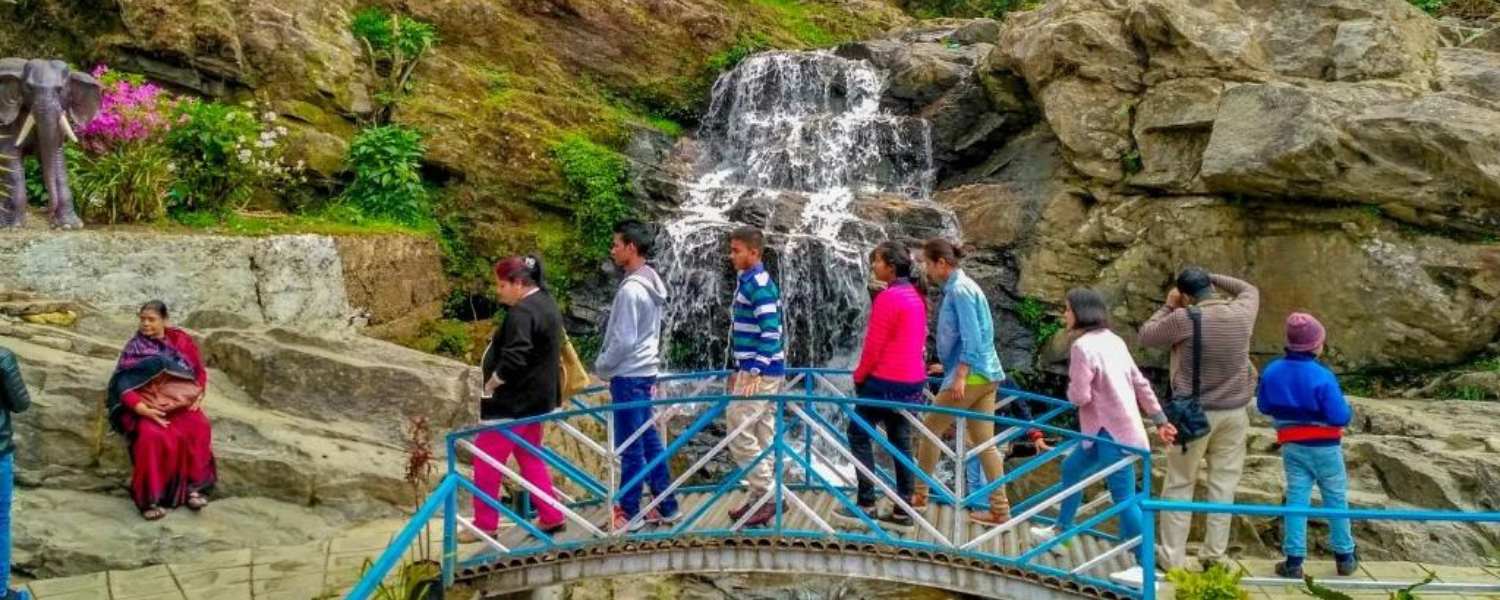
Nature’s Tapestry Unveiled in Darjeeling
The Rock Garden and Ganga Maya Park in Darjeeling are enchanting destinations that showcase the harmonious blend of natural beauty and artistic creativity.
Tucked away in the lap of the Himalayas, these attractions beckon visitors with their lush greenery, cascading waterfalls, and intricately designed landscapes.
Let’s delve into the allure of the Rock Garden and Ganga Maya Park, two gems that adorn the picturesque canvas of Darjeeling.
Key Highlights
1. Artistic Landscaping:
The Rock Garden, also known as Barbotey Rock Garden, is a marvel of terraced landscaping. Created by the Gorkha Hill Council Tourism Department, the garden features terraced steps adorned with blooming flowers, shrubs, and artistic rock formations. The meticulous design of the garden transforms it into a visual masterpiece.
2. Waterfall Extravaganza:
Ganga Maya Park, adjacent to the Rock Garden, is renowned for its cascading waterfalls. The park takes its name from the Ganges (Ganga) and Maya, infusing a sense of spirituality into the natural surroundings. The gushing waterfalls add a melodic rhythm to the serene ambiance, creating a perfect setting for relaxation.
3. Floral Diversity:
Visitors to the Rock Garden and Ganga Maya Park are treated to a vibrant display of flora. The carefully manicured gardens boast a variety of flowers, including dahlias, orchids, and rhododendrons. The riot of colors against the backdrop of the hills makes for a mesmerizing sight.
4. Darling of Photographers:
The picturesque setting of the Rock Garden and Ganga Maya Park makes them a favorite among photographers. Whether capturing the reflection of flowers in the water or the playful interplay of light and shadow, every angle presents a postcard-worthy scene.
5. Recreational Activities:
Ganga Maya Park offers recreational activities, adding to its appeal for families and nature enthusiasts. Boating in the artificial lake, surrounded by verdant landscapes, provides a delightful experience. The park is also equipped with facilities for picnics, making it a popular choice for a day of leisure.
Peace Pagoda and Japanese Temple
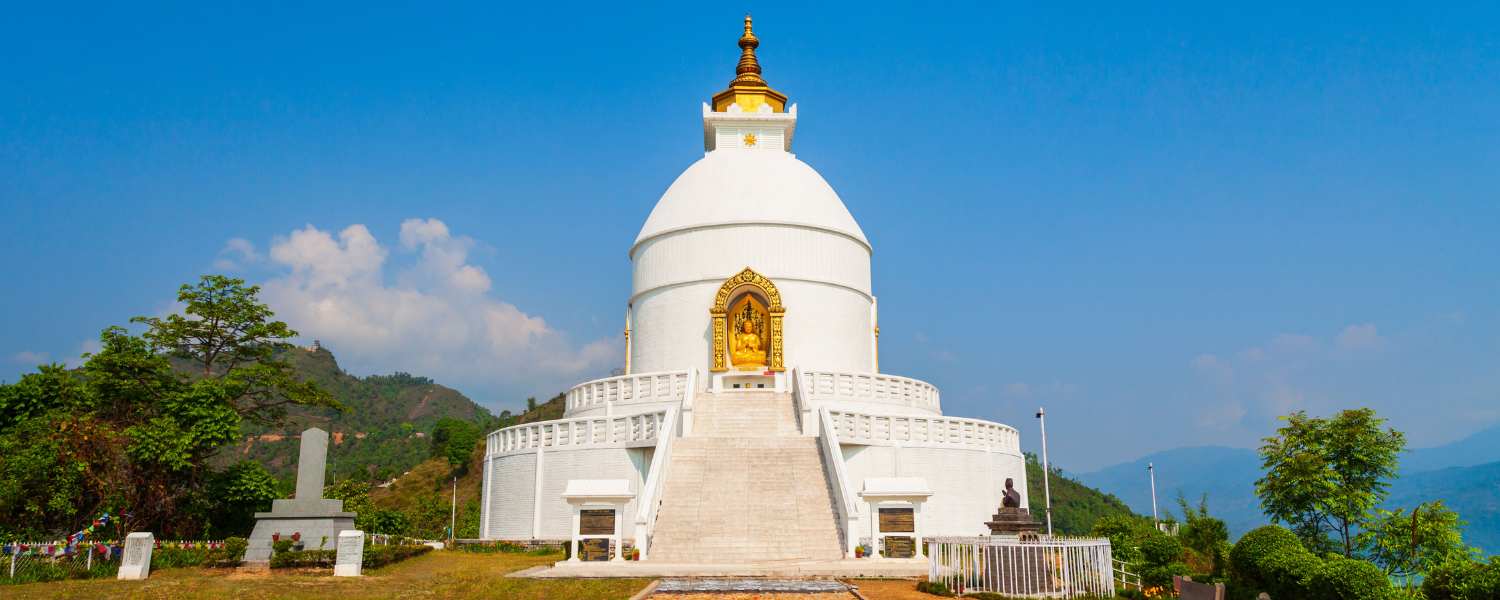
Harmony and Serenity Amidst the Himalayas The Peace Pagoda and Japanese Temple in Darjeeling symbolize peace, spirituality, and cultural unity.
Nestled amidst the majestic Himalayan landscapes, these structures draw visitors seeking solace and a deeper connection with their inner selves.
Let’s explore the serenity and cultural richness that make the Peace Pagoda and Japanese Temple must-visit attractions in Darjeeling.
Key Highlights
1. Architectural Splendor:
The Peace Pagoda, an architectural marvel, reflects the distinctive style of Japanese stupa architecture. Built under the guidance of Nichidatsu Fujii, a Buddhist monk from Japan, the pagoda is characterized by its gleaming white structure and intricate ornamentation.
2. Spiritual Significance:
The primary purpose of the Peace Pagoda is to inspire peace and spread the message of non-violence. Visitors can experience a sense of tranquility as they explore the pagoda and its surroundings. The temple, adjacent to the pagoda, complements the spiritual ambiance with its traditional Japanese design.
3. Panoramic Views:
Perched on the slopes of the Jalapahar Hill, the Peace Pagoda offers panoramic views of the surrounding mountains, valleys, and Darjeeling. The breathtaking vista adds to the meditative atmosphere, making it a perfect spot for introspection.
4. Four Buddha Avatars:
The pagoda is adorned with four golden statues of Buddha, each representing a significant stage of his life. These statues contribute to the pagoda’s cultural and religious significance and serve as focal points for prayer and meditation.
5. Japanese Temple:
Adjacent to the Peace Pagoda, the Japanese Temple showcases traditional Japanese architecture and design. The temple’s serene ambiance, chanting, and the fragrance of incense create a contemplative space for visitors.
Darjeeling Tea Gardens

Savoring the Essence of Darjeeling in Every Cup
When one thinks of Darjeeling, the mind is often filled with visions of lush green slopes dotted with tea bushes and fresh tea leaves wafting through the air.
The Darjeeling Tea Gardens, nestled amid the breathtaking landscapes of the Eastern Himalayas, stand as a testament to the region’s rich tea heritage and contribute to Darjeeling’s global reputation as the “Champagne of Teas.”
Key Highlights
1. Scenic Landscapes:
The Darjeeling Tea Gardens are set against the backdrop of the majestic Himalayan mountains, creating a picturesque landscape that captivates visitors. The rolling hills covered with tea bushes offer a serene atmosphere.
2. Tea Plantations:
Spread across the undulating slopes, the tea plantations are meticulously manicured to cultivate the finest tea leaves. The gardens follow traditional methods of tea cultivation, emphasizing the unique terroir that imparts distinct flavors to Darjeeling tea.
3. Tea Estate Tours:
Many tea estates in Darjeeling open their doors to visitors, offering guided tours that provide insights into the tea-making process.
Visitors can witness plucking, withering, rolling, oxidation, and drying—the key steps that transform freshly picked leaves into the world-renowned Darjeeling tea.
4. Tea Tasting Sessions:
A visit to the Darjeeling Tea Gardens is complete with indulging in a tea-tasting session. Connoisseurs and casual tea drinkers can savor a variety of Darjeeling teas, each boasting its unique aroma, flavor profile, and character.
5. Happy Valley Tea Estate:
Among the prominent tea estates in Darjeeling, the Happy Valley Tea Estate is a popular choice for tourists. The estate, established in 1854, offers guided tours that encompass the entire tea-making process and conclude with a delightful tea-tasting experience.
Padmaja Naidu Himalayan Zoological Park

A Wildlife Haven in the Himalayas Nestled in the heart of the enchanting town of Darjeeling, the Padmaja Naidu Himalayan Zoological Park stands as a testament to the region’s commitment to wildlife conservation and biodiversity.
Named after the illustrious Padmaja Naidu, the daughter of Sarojini Naidu and the former Governor of West Bengal, the zoo is a haven for rare and endangered species, offering visitors a unique opportunity to connect with the diverse fauna of the Eastern Himalayas.
Key Highlights
1. Himalayan Fauna:
The zoo is renowned for its focus on Himalayan fauna, providing a natural habitat for species indigenous to the Eastern Himalayas.
Visitors can witness the diverse wildlife, including the elusive red panda, snow leopard, Himalayan wolf, and various pheasants.
2. Red Panda Breeding Program:
As a significant contributor to red panda conservation, the zoo houses a specialized breeding center for these charismatic creatures.
The Red Panda Breeding Program aims to increase awareness and contribute to the conservation of this endangered species.
3. Snow Leopard Enclosure:
The park features a specially designed enclosure for the elusive snow leopard, allowing visitors to observe these magnificent big cats in a setting that mimics their natural habitat. The conservation efforts for snow leopards are crucial for maintaining the region’s ecological balance.
4. Himalayan Mountaineering Institute:
Adjacent to the zoo is the Himalayan Mountaineering Institute (HMI), founded by Tenzing Norgay and Sir Edmund Hillary. The institute imparts training and houses a museum showcasing mountaineering history and equipment.
5. Tenzing Rock:
For adventure enthusiasts, Tenzing Rock, named after Tenzing Norgay, offers an opportunity for rock climbing. The site is adjacent to the zoo, providing a thrilling experience with its natural rock formations.
Darjeeling Himalayan Railway

A Nostalgic Journey Through Time and Beauty in Darjeeling
Darjeeling, nestled in the lap of the Eastern Himalayas, is adorned with a gem of engineering and natural beauty—the Darjeeling Himalayan Railway.
Fondly known as the “Toy Train,” this narrow-gauge railway has been chugging through the picturesque landscapes of Darjeeling since the late 19th century, creating an enchanting and nostalgic experience for visitors.
Key Highlights
1. UNESCO World Heritage Site:
The Darjeeling Himalayan Railway, declared a UNESCO World Heritage Site in 1999, stands as a testament to the region’s rich history and the significance of its rail transport. It continues to charm travelers with its vintage charm and operational marvel.
2. Joyous Toy Train Rides:
The joyous rides on the Toy Train offer a unique perspective of Darjeeling’s stunning vistas. The train, hauled by a historic steam locomotive, winds through tea plantations, verdant hills, and charming villages, providing passengers with a delightful journey.
3. Batasia Loop:
A highlight of the Darjeeling Himalayan Railway journey is the Batasia Loop, an engineering marvel that offers panoramic views of the Himalayan range. The loop also features the Gorkha War Memorial, adding a touch of history to the scenic beauty.
4. Ghoom Station:
As the highest railway station on the route, Ghoom Station is another noteworthy stop. The station is home to the Batasia Loop and the famous Darjeeling Himalayan Railway Museum, where visitors can delve into the railway’s fascinating past.
5. Heritage Stations:
The journey includes stops at charming heritage stations like Kurseong and Sonada. These stations exude colonial-era architecture and transport passengers to a bygone era, capturing the essence of Darjeeling’s history.
Batasia Loop
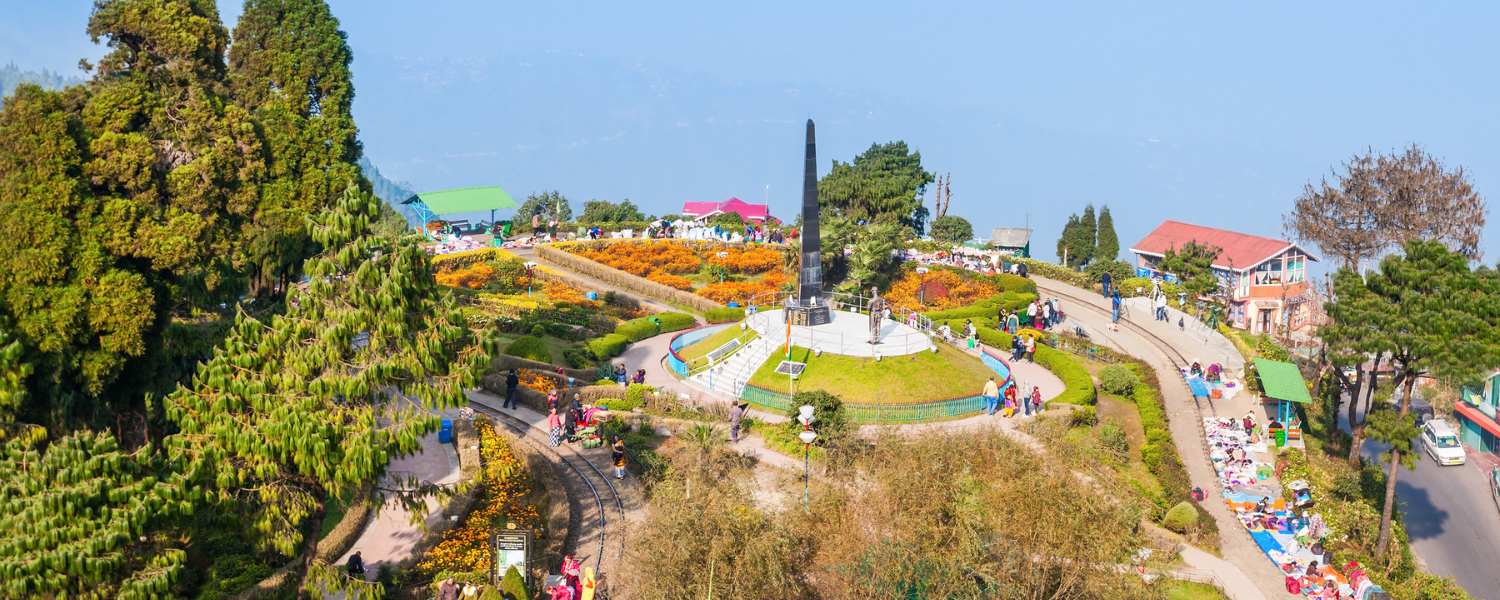
A Quaint Marvel Among the Must-Visit Places in Darjeeling
Batasia Loop, a captivating railway loop, emerges as a charming gem among the delightful places to visit in Darjeeling.
This engineering marvel, nestled amidst the picturesque landscapes of the Eastern Himalayas, offers visitors a unique and enchanting experience.
Key Highlights
1. Scenic Himalayan Views:
Batasia Loop is renowned for its panoramic views of the snow-capped Himalayan range, including the iconic Kanchenjunga.
Visitors can relish the breathtaking scenery as the toy train gracefully negotiates the loop, providing ample opportunities for stunning photographs.
2. Gorkha War Memorial:
At the center of Batasia Loop stands the Gorkha War Memorial, a tribute to the Gorkha soldiers who sacrificed their lives in the nation’s service.
The memorial, surrounded by lush gardens, adds a touch of reverence and historical significance to the site.
3. Joy Ride on the Toy Train:
Batasia Loop is integral to the Darjeeling Himalayan Railway, a UNESCO World Heritage Site. Travelers can embark on a delightful joy ride on the toy train, winding its way through the loop’s circular track, creating a whimsical and nostalgic experience.
4. Floral Splendor:
The well-maintained gardens around Batasia Loop showcase various seasonal flowers, adding a vibrant touch to the surroundings. The floral beauty enhances the overall charm of the place, making it a perfect spot for a stroll.
5. Tea and Souvenir Stalls:
Visitors can unwind at the stalls near Batasia Loop, offering a variety of Darjeeling tea and local handicrafts. It provides an opportunity to savor the region’s flavors while taking in the serenity of the Himalayan landscape.
Tiger Hill
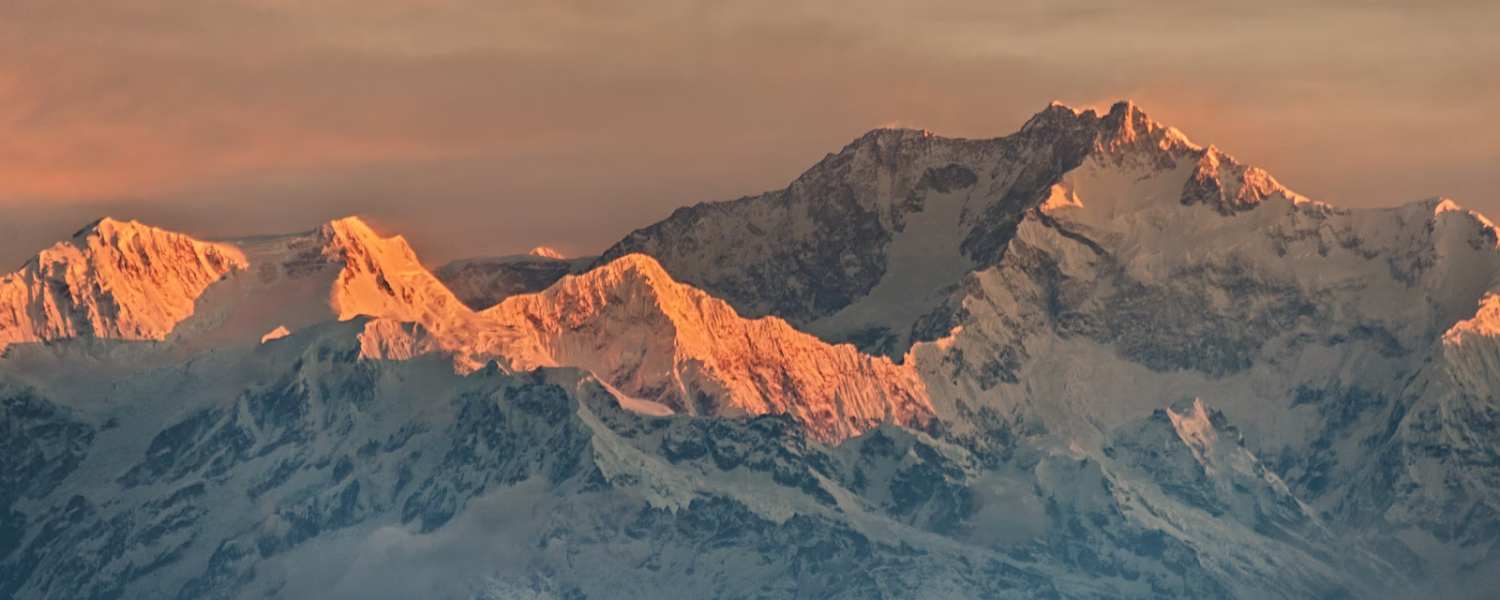
A Panoramic Marvel Among the Must-Visit Places in Darjeeling Tiger Hill stands as a crowning jewel among the captivating places to visit in Darjeeling, offering a breathtaking panoramic spectacle that enchants visitors from around the globe.
This iconic hill, situated in the Eastern Himalayas, is renowned for providing an awe-inspiring vantage point to witness the magical sunrise over the majestic peaks of the Himalayan range.
Key Highlights
1. Spectacular Sunrise Views:
Tiger Hill is celebrated for its unrivaled views of the sunrise, where the first rays of the sun paint the snow-capped peaks of Kanchenjunga and Mount Everest in hues of pink, orange, and gold. The experience is nothing short of magical and is a must-see for Darjeeling travelers.
2. Himalayan Panorama:
Beyond the enchanting sunrise, Tiger Hill offers a mesmerizing panorama of the entire Himalayan range. Visitors can feast their eyes on the grandeur of iconic peaks, including Kanchenjunga, the third-highest mountain in the world, creating an unforgettable visual treat.
3. Historical Significance:
Tiger Hill holds historical significance as the site of the famous “Battle of Tiger Hill” during the Kargil War 1999. The hill’s strategic importance adds a layer of courage and patriotism to its already captivating allure.
4. Accessible by Darjeeling Himalayan Railway:
For a unique and charming journey, visitors can opt to reach Tiger Hill by taking the Darjeeling Himalayan Railway, a UNESCO World Heritage Site known for its scenic route and vintage charm.
Conclusion
Exploring the enchanting town of Darjeeling is a journey filled with natural wonders, cultural richness, and historical significance.
From the tranquil gem of Rimbik, offering panoramic views and adventure opportunities, to the vibrant hubs of Chowrasta and Mall Road, where leisure and shopping converge, Darjeeling unfolds as a diverse tapestry of experiences.
The spiritual sanctuaries of Observatory Hill and the Mahakal Temple provide moments of introspection. At the same time, the biodiversity hotspot of Singalila National Park invites nature enthusiasts to immerse themselves in the pristine landscapes of the Eastern Himalayas.
Nightingale Park, Lloyd’s Botanical Garden, and the Rock Garden with Ganga Maya Park offer serene oases, each with its unique blend of beauty and relaxation.
